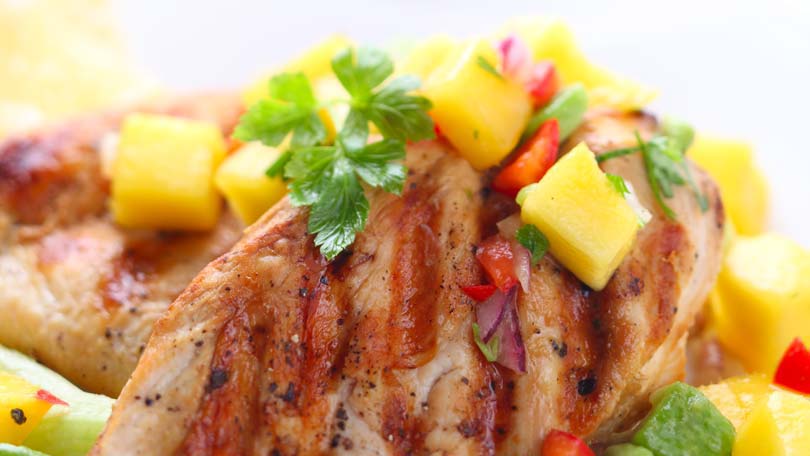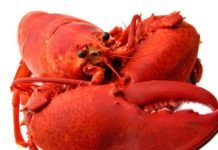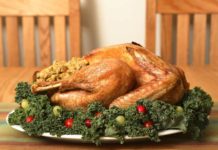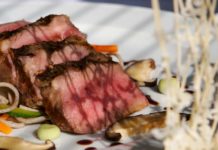
In over 30+ years as a professional cook, and chef, there is one Truth that I have learned. Boneless, skinless chicken breasts are the touchiest piece of meat there is, bar none. Cooking perfect fish is child’s play, by comparison. Sometimes it seems as if the chicken breasts will dry out if you even just look at them funny. And dry chicken breasts are abominable. So, I am often asked how to make moist, boneless, skinless chicken breasts.
Like any other meat, it is important to understand the entreè, and develop a relationship with it. You need to learn its deepest darkest secrets. Americans have become more health-conscious in recent decades, which has done much to bolster the popularity of chicken. Now, the culinary world is flooded with all types of chicken recipes. And it’s not a bad thing. Chicken is lower in fat than all other meats except fish. The white breast meat is considered the prime part of the bird, being lower in fat than the dark meat. And it is typically made even lower in fat by removing the skin. It is made more versatile, and easier to prepare by removing the breast bone. However, the skin serves as a protective layer, keeping the meat from being so easily bruised, holding in moisture, and supplying it’s own moisture and flavor. With all of that gone, we have a naked piece of meat with little flavor of it’s own, and nothing whatsoever to hold moisture in. More often than not, chicken breasts prepared by less than professional-level cooks tend to be dry, chewy, and tasteless. So, how to we get the breasts to the correct safe serving temperature of 160ºF, without drying them out?
Fortunately, there are several Tricks of the Trade for preparing boneless, skinless chicken breasts. The first one is called brining. Placing meat in a salt brine solution causes the meat to draw-in the water, making them plump and succulent. They will also soak in any flavorings you add to the water. You can brine them thawed, or frozen. In a large mixing bowl, add enough water to cover your chicken breasts, allowing room for them in the bowl. Now drain the water into another container. You can place the chicken breasts in the mixing bowl now. Add at least 6 tablespoons of salt to the water, and stir until it is all dissolved. You can add other flavorings to the water if you want, such as Terryaki Sauce, Soy Sauce, Liquid Smoke, lemon, or lime juice, tequila, wine, etc… Just don’t over do it. The flavor will be drawn into the chicken, instead of just on top, as in other methods. Pour the brine over the breasts, cover the bowl, and set it in the refrigerator for 4 hours for thawed breasts, or overnight for frozen ones. When you are ready to cook, drain the breasts, discard the water, and rinse the breasts well under cold running water. Now they are ready for use in any recipes for chicken breasts. Pat them dry, and cook them however you want. You still need to watch them closely, though. Do not over cook them. Measure the internal temperature frequently with a meat thermometer. When the temperature in the thickest part is 160ºF, they are done.
One of the most forgiving cooking methods to avoid drying out breasts is cooking them in parchment paper, or Blancs de Poulet sans Peau et sans Os, en Papillote. In cheaper restaurants, Poulet en Papillote (in most French Restaurants, the longer the name of the dish, the more you’re gonna pay for it…). These are super-juicy and moist, with an explosion of flavor. Start by pre-heating the oven to 425ºF. Spread a large piece of parchment paper over your prep area, making sure you have at least double the amount you think you will need. Spread the chicken breasts on the paper in a single layer, with each breast touching the one next to it. Season them however you’d like, with spices, salt, pepper, lemon/lime juice, white wine, or my personal favorite…the Worlds Greatest hot sauce…El Yucateco Green Habanero ( If you decide to use this, be warned, it has a Half-Life, and glows in the dark! A milder choice is El Yucateco Chipotile. It is wonderful on chicken, and slightly less lethal if you’re not used to it). Cover the chicken breasts with a second layer of parchment paper, fold all of the edges up and over the sides, and roll them tightly to seal them. Make sure the chicken stays in a single layer. Bake for 10-15 minutes. If using frozen breasts, bake for 30-50 minutes. Check them with a meat thermometer periodically. When they are 160ºF, they are done.
If you are on a busy schedule, here is a suggestion on how to cook moist boneless, skinless chicken breasts while you are at work. This works best with frozen breasts, if you work 8+ hours a day. Before you go to work, break out the crock-pot. Stack the chicken breasts in the slow cooker, and add 1 cup of water, and any flavorings and spices you want. Set it on low. If you can, at lunch, you can come home and re-arrange the breasts and allow them to continue to cook. If you can’t don’t worry about it. They’ll still be fine. When you come home from work, viola! You have perfectly cooked, moist delectable chicken breasts, just waiting for your attention. You can make some rice, or any side you want to go with them, and chow-down.
My final suggestion is if you want the absolute most tender, moist, almost melt-in-your-mouth boneless, skinless chicken breasts, then try pressure cooking them. This is another of my favorite ways to cook. Just load your pressure cooker with either thawed, or frozen breasts, throw in some salt and pepper, potatoes, leftover veggies, carrots, celery, or whatever is lying around in the fridge, put in about 1/3 the pot full of water, seal the lid, and build up the pressure to High. Cook for 12-15 minutes for thawed, or 20-25 minutes for frozen breasts, release the pressure, and you’re all set for a great meal. This is one of the best recipes for chicken breasts there is. They come out falling-apart tender, infused with the complex flavor of the juices from the veggies, and their own sealed in juices. The only trick to this is to keep your ingredients consistent. If you are using frozen chicken breasts, then the other ingredients need to also be frozen, or they will cook down to nothing before the chicken is done. If you are using thawed breasts, then you can use either frozen, or thawed veggies. And don’t worry about seasonings. With this method, they wont need any.
When you have mastered how to cook moist boneless, skinless chicken breasts consistently, you will have truly achieved greatness as a culinary artist.





